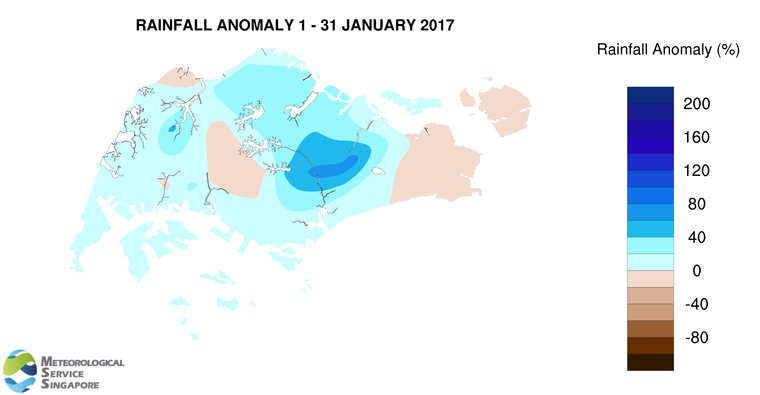Short-duration thundery showers on some days
Singapore, 1 February 2017 – In the first fortnight of February 2017, the prevailing Northeast Monsoon season is forecast to enter its dry phase, which is characterised by drier weather and occasionally windy conditions. During this period, the low level winds are forecast to blow predominantly from the northeast or northwest.
2 Compared to the second half of January 2017 when Singapore experienced wet weather conditions on most days, the first fortnight of February 2017 is forecast to be drier and warmer. In addition, the daily temperature is expected to range between 23°C and 33°C, and could reach a high of around 34°C on some days.
3 Climatologically, February is the driest month of the year. During the dry phase of the Northeast Monsoon season, the monsoon rain belt typically lies south of the Equator, resulting in fewer rain days[1] for Singapore. For the first fortnight of February 2017, short-duration thundery showers due to strong solar heating of land areas coupled with convergence of winds can still be expected mostly in the afternoon on four or five days. Rainfall for the first half of February 2017 is forecast to be below normal.
4 For updates of the daily weather and haze forecast, please visit our MSS website (https://www.weather.gov.sg), NEA website (www.nea.gov.sg), or download the myENV app, MSS’ Weather@SG app.
[1] A rain day is defined as a day in which rainfall recorded for that day is 0.2mm or more.
Review: 1 – 31 January 2017
5 Northeast Monsoon conditions prevailed over the region in January 2017 with the low level winds blowing predominantly from the northeast and occasionally from the northwest.
6 The region experienced two episodes of monsoon surge[2] in the second half of January 2017. The first monsoon surge on 22-24 January 2017 brought overcast and occasionally windy conditions with periods of widespread moderate to heavy showers to Singapore. Over the Lunar New Year weekend on 28-29 January 2017, the second monsoon surge brought widespread showers mostly over the sea areas south and east of Singapore, while brief light to moderate afternoon showers fell over the island. For most other days in January 2017, Singapore experienced thundery showers in the afternoon. The highest total daily rainfall recorded during the month was 106.0mm around the Kallang area on 23 January 2017.
7 In January 2017, the daily maximum temperatures ranged between 25.9°C and 35.1°C, and the daily minimum temperatures ranged between 21.7°C and 25.4°C. While cooler temperatures were recorded in the second half of the month due to rainy weather, there were some warm days during the month as well. At the Changi climate station, the daily maximum temperature of 33.7°C recorded on 8 January 2017 surpassed the record highest daily maximum temperature for January by 0.1°C set on 27 January 1998. In addition, the mean monthly temperature of 26.9°C for January 2017 is 0.4°C above the long-term mean for January.
8 There were 21 rain days recorded for the month at the Changi climate station, which is significantly higher than the long-term average of 13 rain days for January. Despite the high number of rain days, the monthly rainfall recorded at the climate station in January 2017 was near normal as the rain was less heavy compared to other parts of the island. Most parts of Singapore received above normal rainfall in January 2017. The highest rainfall of 389.4mm (70% above average) was recorded around Paya Lebar area. Rainfall was lowest around Clementi where 177.6mm (18% below average) was recorded.
[2] A monsoon surge refers to a strengthening of winds over the South China Sea, causing extensive rainclouds to form over our surrounding region.
CLIMATE STATION STATISTICS FOR FEBRUARY (Climatological reference period: 1981 – 2010)
| Mean daily maximum temperature | 32.0 °C |
| Mean daily minimum temperature | 24.3 °C |
| Mean monthly temperature | 27.1 °C |
| Mean rainfall for the month | 112.8 mm |
| Mean number of rain days | 8 |
| Highest monthly mean daily maximum temperature | 33.5 °C (2010) |
| Lowest monthlymean daily minimum temperature | 23.0 °C (1982) |
| Highest monthly rainfall | 470.4 mm (1984) |
| Lowest monthly rainfall | 6.3 mm (2010) |

